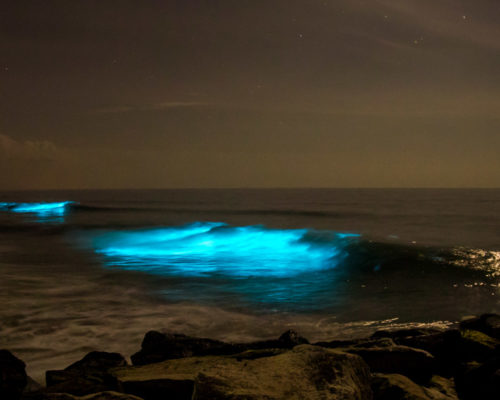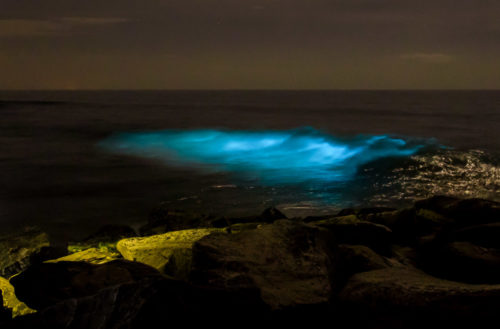
Across the various beaches of Karnataka coast, the waves at night are showing a strange glow, due to bioluminescence. For many of us, the only awareness of bioluminescence—the emission of light by living organisms—is the sight of fireflies. For others, the magic moment is a “phosphorescent sea,” where myriads of microscopic sources emit flashes of light when waves or our steps on wet sand stir the water as seen in the photograph captured by friend Mohit Shenoy K off the Coast of Karnataka, India last week. All photographs in this blog along with their Copyright belongs to him. I am very grateful for allowing me to use these photos for this blog.
The bioluminescence we are witnessing in these pictures may be due to Noctiluca scintillans, commonly known as the sea sparkle. It is a free-living, marine-dwelling species of dinoflagellate that exhibits bioluminescence when disturbed (popularly known as mareel). Its bioluminescence is produced throughout the cytoplasm of this single-celled protist, by a luciferin-luciferase reaction in thousands of spherically shaped organelles, called scintillons.

Open ocean blooms of the dinoflagellate Noctiluca is a common feature all along the west coast of India towards the last phase of the productive seasons. There are two form of Noctiluca – Green & Red. Both forms are known to have bioluminescence.
Green forms of Noctiluca that are autotrophic (An organism capable of synthesizing its own food from inorganic substances using light or chemical energy) due to the presence of the photosynthetic endosymbiont, Pedinomonas noctilucae. This type of bloom is much more restricted to a temperature range of 25–30°C and occurs mainly in the tropical waters of south-east Asia, Bay of Bengal (east coast of India), in the eastern, western and northern Arabian Sea and the Red Sea. They are considered relatively harmless.

Unlike this, blooms of the red Noctiluca which appears along the Southwest coast towards the end of the upwelling seasons (June-September) are phagotrophic in nature. N. scintillans red result in a strong pinkish red or orange discolouration of the water (like tomato soup). They lack any photosynthetic endosymbionts and feed predominantly on diatoms, bacteria, protozoans, copepods, eggs of copepods and fishes and detritus. Noctiluca is a competitor for the food of oil sardine (Sardinella longiceps) as both feed on diatoms like Coscinodiscus, Nitzschia, Fragilaria and Thalassiosira etc and the appearance of Noctiluca bloom may have a bearing on the decrease in catch of oil sardines from such areas.
N.scintillans which feed on Pseudonitzschia are known to produce toxins that can cause fish kill and lead to shellfish poisoning in humans. However, it is interesting to note that Noctiluca can feed toxic phytoplankton and thus function as a vector for the transfer of such toxins to higher trophic levels.

A high population of them along the west coast during the monsoons might be due to nutrient enriched water from upwelling and estuarine discharges, which probably sets the stage for blooming of non-autotrophic forms like Noctiluca. Normally along the west coast, red tides are generally reported between the July to October, coinciding with the end of the upwelling season, when the weather is warmer with far longer hours of sunshine. Noctiluca multiplies rapidly and form aggregation only when the calm conditions prevail in the area because turbulent conditions seem to be unfavourable for their rapid growth and blooming. Another factor is diatom abundance, if Noctiluca is present or carried into an area where there is rich diatom population, they multiply rapidly, and form bloom provided the sea is calm.
Bioluminescence is the production and emission of light by a living organism. It is a form of chemiluminescence. In a general sense, the principal chemical reaction in bioluminescence involves some light-emitting molecule and an enzyme, generally called the luciferin and the luciferase, respectively.
In truth, bioluminescence is everywhere on earth, especially in the oceans, from the depths where no sunlight penetrates to the surface, where it powers photosynthesis. Emission of light is a function that was invented, reinvented for different reasons, with different chemistries and in different species, and perhaps lost countless times during evolution. There is no way to tell.

On a tree of life seen above, the scattered red dots make this point. Many mushrooms are bioluminescent, but no plants; many insects emit light, but no spiders. Among vertebrates, bioluminescence is found abundantly in fish, but not in frogs, salamanders, birds, reptiles, or mammals.
Today’s reptiles, birds, and mammals communicate by sounds, odours, touch, and visual signals. Why did so many species fail to acquire the ability to emit light, or to take advantage of a symbiosis with bioluminescent bacteria, for example, as many fish and squid did? That mystery of evolution is not yet cracked.

The emission of visible light requires energy. We know how hot a light bulb must get before emitting light, yet evidently, a firefly does not fry. This is because the mechanisms of light production in the Firefly and in the light bulb are different. The electricity passing through the bulb’s filament heats it, and this thermal energy is then radiated as light.
Within the lantern of the firefly, a biochemical reaction is the source of the emission. A specific molecule is generated in a high energy state, out of thermal equilibrium with its surrounding; this “excited” molecule immediately radiates its surplus energy as light, usually within a nanosecond, and very little heat is produced.

Bioluminescence is of great interest because, despite its being part of complex biological systems, the light itself results from a single, very specific step in a biochemical reaction. All bioluminescence is without exception reactions of oxygen (O2) with molecules specific to a group of organisms, catalysed by specific enzymes. All involve the production of transient peroxides, where the O—O bond between the oxygen atoms is weak and easily broken. It is the energy released by this type of reaction that brings a product to an “excited state,” from which the photons of bioluminescence are emitted when the product falls back to its lower, “ground state” level.
What makes bioluminescence so fascinating is that diversity is found at all levels, from the organisms themselves and the use they make of the light they emit—defence, offence, communication, propagation —to the anatomy of the light organs and the biochemical reactions ultimately emitting the light as photons

Bioluminescent organisms living in the oceans far outnumber their terrestrial counterparts, which, to be sure, are restricted to a space on earth only some one-hundredth of that of the oceans’ volume. Moreover, and remarkably so, luminous organisms are essentially absent in fresh water, and a fully satisfactory explanation for this has never been found.
In oceans that can be miles deep, sunlight penetrates significantly only about 200 meters below the surface and becomes increasingly blue with depth. It is in the top layer of the ocean, where photosynthesis is at work and life is abundant, that many of the marine bioluminescent creatures live.
Below is a dark blue twilight zone, and from 1000 meters down darkness is constant and total, except for bioluminescence. Apart from the environment of hot vents, where a special fauna thrives but no bioluminescence has been reported, any life below 1000 meters owes its existence to the nutrients that slowly drop down to the ocean floor. This immense dark, cold, and a sparsely populated world (someone calculated that there are only one female anglerfish per cubic mile in this zone) is where some of the most outlandish bioluminescent fishes cruise for a living.

The functions of bioluminescence in different organisms all fall under four major headings: defensive, to escape predators; offensive, to aid in predation; communication; and propagation. Its survival value today is certainly based on its functional importance, but billions of years ago, when oxygen first appeared on earth as the result of photosynthesis, it would have been toxic to all organisms, which had been living in an atmosphere lacking it, and the enzymes of bioluminescence may have played a critical role in oxygen removal. The study of bioluminescent species has opened a treasure trove of exquisite tools for biological research.
Fireflies, luminous bacteria, crustaceans, and jellyfish, among others, have given us enzymes, substrates and fluorescent proteins that are now used all over the world in all fields where molecular biology and imaging techniques are applied. On the practical side, we go to Firefly or bacterial bioluminescence, for example, to check that our meat or our drinking water is not contaminated.
At the same time, but at a deeper and more fundamental level, the study of luminous bacteria has taught us mechanisms by which individual bacteria chemically communicate with and count others of their kind and regulate the expression of specific genes accordingly. This is a discovery of fundamental importance for how we look at bacteria more generally.
The basic mechanism of such cell- to- cell communication, dubbed “quorum sensing,” is now understood and shown to play a critical role in diseases such as cystic fibrosis, for example, as well as in microbial biofilm formation and some fascinating symbioses. Bioluminescence was once thought of as merely an esoteric area of research has now acquired a very significant role in science.
References
Newton Harvey’s book is the classic text; it describes most organisms known to emit bioluminescence. It truly put bioluminescence on the map of academic research. After 60 years, it remains an invaluable resource. His later publication on the history of bioluminescence before 1900 is extremely interesting. Another important book, edited by P. J. Herring, collects chapters authored by experts in their fields on different aspects of bioluminescence, from photophysics to evolution. Pierebone and Gruber’s book is a lovely presentation on bioluminescence. It introduces readers to some of the scientists who carry on the work, as well as to organisms they selected for study, and it explains to the lay reader, in simple terms, how bioluminescence works. The book by O. Shimomura is a goldmine of very specific information on the biochemistry of bioluminescence.
- Harvey, E. N. 1952. Bioluminescence. Academic Press, New York.
- Harvey, E. N. 1957. A History of Luminescence from the Earliest Times until 1900. Memoirs of the American Philosophical Society 44:1– 692.
- Hastings, J. W. 2012. Bioluminescence. In Cell Physiology Sourcebook: Essentials of Membrane Biophysics, 4th ed., ed. N. Sperelakis, pp. 925–947. Academic Press, New York.
- Herring, P. J., ed. 1978. Bioluminescence in Action. Academic Press, New York.
- Pieribone, V., and D. F. Gruber. 2005. Aglow in the Dark. The Belknap Press of Harvard University Press, Cambridge.
- Shimomura, O. 2006. Bioluminescence: Chemical Principles and Methods. World Scientific Publishing Co., Singapore.
- ThérèseWilson and J WoodlandHastings. 2013 Bioluminescence: living lights, lights for living. Harvard University Press, Cambridge
- Wilson, T., and J. W. Hastings. 1998. “Bioluminescence.” Annual Review of Cell Developmental Biology 14:197–230.


New thought….Thaks for the information and kudos to your photography…
i would love to experience this phenomenon directly. Can you tell me in which beach in Dakshin Kannada are we most likely to see it?
Wow! Enlightening!!
ಸಿವಿ ರಾಮನ್ನರ ಸಮುದ್ರದ ನೀಲಿಮೆ ಕುರಿತ ಸಂಶೋಧನೆ ಶುದ್ಧ ಭೌತವಿಜ್ಞಾನವಲ್ಲವೇ? ಲೇಖನದಲ್ಲಿ ನೀವಂದಂತೆ ಮಿಣುಕುಹುಳ ಆಯ್ತು, ಹಾಗೇ ‘ಗ್ಲೋವರ್ಮ್’ (ಕಂಬಳಿ ಹುಳದಂತೇ ಹರಿದಾಡುತ್ತವೆ, ಹಾರಲಾರವು) ಕೂಡಾ ಇದೆಯಲ್ಲ – ಕುಮಾರಪರ್ವತದ ಮಳೆಗಾಲದ ರಾತ್ರಿ ಕಂಡಿದ್ದೆ. ಕೆಲವು ಕುಂಬು ಮರಗಳೂ ಸ್ವಯಂಪ್ರಕಾಶ ಬೀರುವುದನ್ನೂ ಕಂಡಿದ್ದೇನೆ.
Wonderful information Dr. Krishna Mohan
Excellent article and backed with good photos
Very informative article, thanks sir
Thank you for details.
U can rgt now see this Scenic view in Mangalore beaches
Hello, is it visible at all times on Udupi’s Mattu Beach?
No, it is just for few days soon after end of Monsoon. This year it lasted for a week. last year it was there for only 2-3 days.